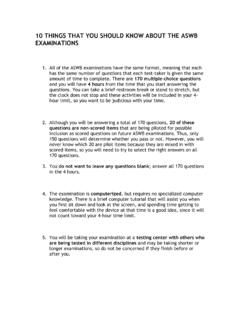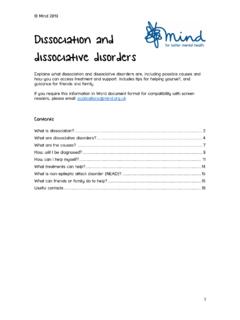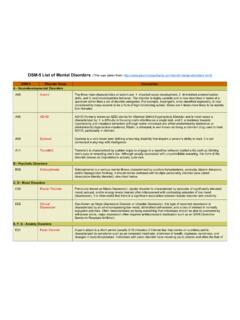Transcription of DSM-5 List of Mental Disorders - Stony Brook Medicine
1 DSM-5 List of Mental Disorders #. A - Neurodevelopmental Disorders Autism The three main characteristics of autism are: 1. impaired social development, 2. diminished communication skills, and 3. restrictive/repetitive behavior. The disorder is highly variable and is now described in terms of a spectrum rather than a set of discrete categories. For example, Asperger's, once classified separately, is now considered by many experts to be a form of high-functioning autism. Males are 4 times more likely to be autistic than females. ADHD list of Mental Disorders ADHD (formerly known as ADD) stands for Attention Deficit Hyperactivity Disorder and in most cases is characterized by: 1. a difficulty in focusing one's attention on a single task, and 2. a tendency towards hyperactivity and impulsive behaviors (although some individuals are either predominantly inattentive or predominantly hyperactive-impulsive).
2 Ritalin, a stimulant, is well known as being a common drug used to treat ADHD, particularly in children. Dyslexia is a very broad term defining a learning disability that impairs a person's ability to read. It is not connected in any way with intelligence. Tourette's is characterized by sudden urges to engage in a repetitive behavior (called a tic) such as blinking one's eyes or smacking one's lips . Although usually associated with uncontrollable swearing, this form of the disorder (known as Coprolalia) is actually quite rare. B - Psychotic Disorders Schizophrenia is a serious Mental illness characterized by auditory hallucinations, paranoia, bizarre delusions, and/or disorganized thinking. It should not be confused with multiple personality disorder (now called dissociative identity disorder), described below. C, D - Mood Disorders Bipolar Disorder was previously known as Manic-Depression.
3 Bipolar disorder is characterized by episodes of significantly elevated mood, arousal, and/or energy levels (mania) often interspersed with contrasting episodes of low mood (depression). It is often noted that there is a significant association between bipolar disorder and creativity Clinical Depression also known as Major Depressive Disorder or Unipolar Depression, this type of recurrent depression is characterized by an all-encompassing low mood, diminished self-esteem, and a loss of interest in normally enjoyable activities. Often misunderstood as being something that individual s should be able to overcome by will-power alone, major depression often requires antidepressant medication such as an SSRI (Selective Serotonin Reuptake Inhibitor). DSM-5 List of Mental Disorders #. E, F, G - Anxiety Disorders Panic Disorder - A panic attack is a short period (usually 5-10 minutes) of intense fear that comes on suddenly and is characterized by symptoms such as an increased heart rate, shortness of breath, dizziness, numbness, and changes in body temperature.
4 Individuals with panic disorder have recurring panic attacks and often the fear of the attacks themselves become the focus of their anxiety. Panic Disorder often occurs together with Agoraphobia (E02), the fear of public places. A phobia is a persistent fear of a certain object or situation in which the individual goes to great lengths to avoid the object or situation in a way that is irrational and disproportional to the actual danger posed. Common phobias include a fear of insects, dogs, boats, needles, airplanes, elevators, etc.). Social Anxiety Disorder (E04) is a special type of phobia in which the individual has an extreme fear of social interaction. Generalized Anxiety Disorder (often shortened to GAD) is characterized by disproportionate worry about everyday things (such as money, health, or relationships) that is ongoing and uncontrollable. It is often expressed in the form of headaches, fidgeting, nausea, irritability, fatigue, or insomnia.
5 OCD stands for Obsessive-Compulsive Disorder and is characterized by uncontrollable thoughts (obsessions) that lead to repetitive behaviors (compulsions) aimed at relieving the anxiety brought on by those thoughts. Common compulsions include excessive hand washing, repeated checking, nervous rituals, or extreme hoarding. Unlike those with Obsessive-Compulsive personality Disorder (OCPD), individuals with OCD often recognize that their obsessions are irrational and therefore experience greater anxiety and feelings of helplessness. PTSD stands for Post-traumatic Stress Disorder and can develop after exposure to extreme trauma such as sexual abuse, physical assault, or certain wartime experiences. Symptoms include flashbacks, nightmares and hypervigilance. Prolonged exposure to trauma in which there was no viable means of escape can lead to a distinct but related disorder known as Complex Post-traumatic Stress Disorder (C-PTSD) H - Dissociative Disorders Depersonalization Disorder is characterized by frequent feelings of detachment from oneself combined with an awareness of the detachment.
6 To someone experiencing depersonalization, the external world feels strange and unreal and a person can even get the sense that they are watching themselves from a third person perspective. However, unlike in psychosis, the individual remains very much aware of his/her own existence and is, in fact, overly aware of it. For this reason, depersonalization disorder is often associated with the philosophy of existentialism. DSM-5 List of Mental Disorders #. Dissociative Identity Disorder (DID) formerly known as multiple personality Disorder (MPD). Dissociative Identity Disorder (DID) is a controversial diagnosis in which an individual has two or more distinct personalities, each with their own memories and patterns of behavior. The development of these multiple personalities is a coping mechanism caused by extreme trauma or abuse at an early age (prior to when a sense of a unitary Self forms).
7 J - Somatic Disorders A person who suffers from Illness Anxiety Disorder is commonly known as a hypochondriac. Such as person constantly worries about their health even when they have no reason to do so and often any minor symptom is perceived as being a sign of a serious illness. Conversion Disorder formerly known as hysteria (a common 19th century diagnosis made exclusively in women), conversion disorder occurs when patients suffer apparently neurological symptoms -- such as numbness, paralysis, or fits -- but without a neurological cause. The term originates in Freud's belief that, in such cases, a person's anxiety is being 'converted' into physical symptoms. K - Eating Disorders Anorexia nervosa is characterized by a distorted self-perception and an irrational fear of gaining weight resulting in excessive food restriction and extreme weight loss. It usually develops during adolescence and early adulthood and can lead to serious metabolic and hormonal problems.
8 Bulimia nervosa is characterized by binging (eating a large amount of food in a short amount of time) followed by purging (an attempt to rid oneself of the food consumed -- typically by vomiting, taking a laxative, and/or exercising excessively). The binge/purge cycle is often followed by periods of fasting. M - Sleep Disorders Narcolepsy is a chronic sleep disorder characterized by excessive sleepiness and sudden sleep attacks at inappropriate times during the day. People with narcolepsy usually also experience disturbed night-time sleep (insomnia). It is related to cataplexy -- a sudden but short-lasting loss of muscle tone, often triggered by emotions DSM-5 List of Mental Disorders #. Q - Impulse Control Disorders Oppositional Defiant Disorder, or ODD, is characterized by an ongoing pattern of anger-guided disobedience and defiant behavior toward authority figures which goes beyond the bounds of normal childhood behavior Some examples of conduct disorder include kleptomaniacs, who suffer from an uncontrollable urge to steal items even though they do not need them (nor even lack the money to pay for them), and pyromaniacs who deliberately start fires for gratification or relief.
9



